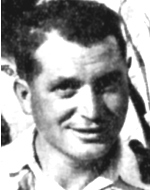Eisenberg, Aharon
Son of Reizel and Yehiel-Yosef was born on 18.6.1920 in Warsaw, the capital of Poland, the eldest son of a large Hasidic family, and was in close contact with the Admorim of Amshinov and Radzyn. Aharon studied in a Polish elementary school, in “Hadarim” and “Yeshiva”. Despite his parents’ opposition, he joined the Hashomer Hadati at the age of 15 and was active in the circles, the guidance and the wall newspaper of the nest, where he published poems full of emotion in Yiddish. He worked in training with his company in Bialystok and later in Lodz and devoted himself to work, to self-training, and to activities in the cultural and social life of his group. When World War II broke out, he came to say goodbye to his parents in Warsaw. He crossed the borders and through the Russian-occupied zone reached Lithuania. He joined the “Ba – Derech” pioneering group of Hashomer Hadati. He moved to the Lamerhav group in Panevezys and in 1941 immigrated to Israel with his friends through Russia and Turkey. The British authorities found a defect in his papers and held him for about 20 months as an “illegal” immigrant in the Atlit, Mizra and Latrun camps. After his release he worked for a while in knitting in Tel Aviv and expects to settle with members of the “Lamerhav” group. When the settlement plan was canceled, at the beginning of 1944 he joined Kfar Etzion. He found his place in the plantation industry and his list “A trip to the orchard” (published in the pamphlets on the 5th of Elul 5707) shows how connected he was to every tree and tree, and so he also struck roots in the Hebron hills. Two brothers, who had moved to Montevideo, the capital of Uruguay, offered to send him money and documents to come to them, but he did not respond to this, and chose his girlfriend, who was transferred to Jerusalem at the beginning of the Arab attacks in the winter of 1948. Aharon remained to take care of the orchards of the village, and to work in the distant groves he would go out armed with a rifle and grenades. In addition, he participated in guarding, training and fortifications. In recent days he was forced to abandon his friends from the plant world and devote himself entirely to the defense of the place. On 12 May, the Arab Legion and irregular forces attacked the Gush and managed to locate it in two. The next day, the day before the declaration of the establishment of the state, on May 13, 1948, the enemy continued the heavy attack and the Legionnaires broke into Kfar Etzion and were followed by masses of Arabs on the day of the fall of Gush Etzion. 1948) -12) fell in his position in the northwestern section of the camp. On the fifteenth day of March 17, 1949, he was transferred to the military cemetery at Mount Herzl in Jerusalem with the other victims of the Gush.
